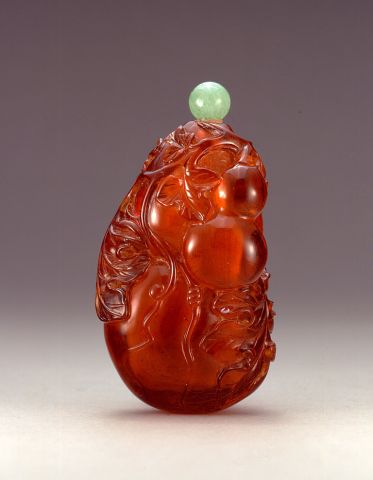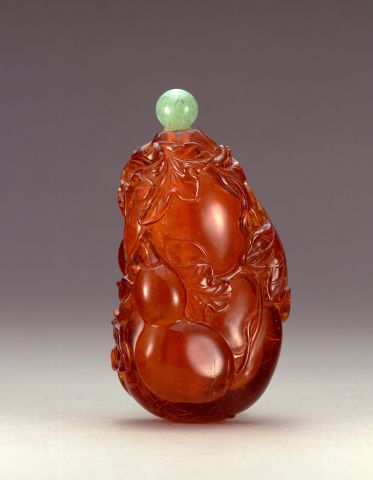


Bottle ID: 474
CARVED, DOUBLE GOURD FORM
Date: 1750-1800
Height: 63 mm
Amber, well hollowed, the translucent golden material carved in the form of a double gourd with two smaller gourds carved in relief among twisting leafy vines.
Possibly imperial, attributed to the Palace Workshops.
Similar Examples:
Chang Lin-sheng. Snuff Bottles in the Collection of the National Palace Museum, Taipei, Taiwan, 1991, p. 259, no. 388.
Moss, Hugh, Victor Graham and Ka Bo Tsang. The Art of the Chinese Snuff Bottle - The J & J Collection, 1993, Vol. II, p. 491, no.290.
Provenance:
Clare Lawrence Ltd.
The Monimar Collection
Robert Hall
The Lionel Copley Collection
Exhibited:
Christie's, St. James', London, June 1996
Annual Convention, ICSBS, Hong Kong, October 1996
Published:
Lawrence, Clare. Miniature Masterpieces from the Middle Kingdom - The Monimar Collection of Chinese Snuff Bottles, 1996, pp. 64-65, no. 26.198
Amber is a fossilized tree resin and not, as some collectors think, sap, and occurs in rock formations. It has been appreciated since Nepolithic times for its natural organic beauty, color and healing powers. It originates as a soft sticky tree resin sometimes containing plant and animal inclusions. The first historical mention of the material amber was possibly by the Greek philosopher, Theophrastus in the 4th century BCE. The English term ‘amber’ has been used since the beginning of the 15th century and is derived from the Arabic word ‘anbar’ via Medieval Latin (‘ambar’) and Old French (‘ambre’). Amber is lighter than stone, but in its solid form not light enough to float in water. Amber from the Baltic Sea in Russia is either cast up by the waves or mined and has been extensively traded since antiquity. Snuff bottle collectors refer to opaque yellow or brown amber as Baltic amber, but not all amber that comes from that region is opaque. Amber snuff bottles come in a range of colors from lemon yellow, through orange to brown and even red and black.
In every sense the quality of this bottle raises it from the prolific and often mundane bottles of this genre. The flawless material is clear, rich and honey-colored. The delicate carving is spare, elegant and fluid. In execution it is far nearer to eighteenth century white jade bottles than to its siblings and can be readily compared to the best of that group.
< Back to full list

 English
English 中文
中文